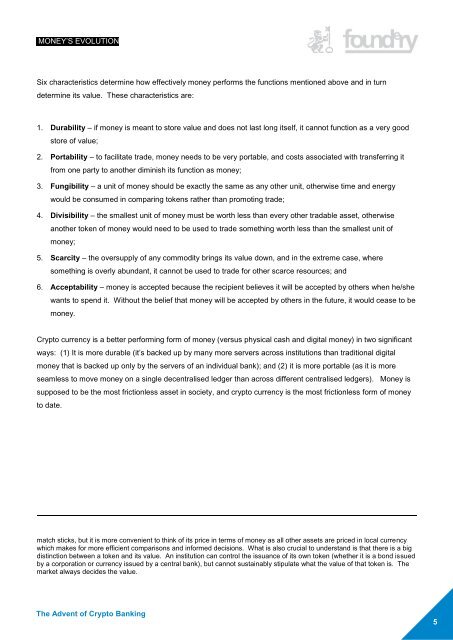The Advent of Crypto Banking
The_Advent_of_Crypto_Banking
The_Advent_of_Crypto_Banking
Create successful ePaper yourself
Turn your PDF publications into a flip-book with our unique Google optimized e-Paper software.
MONEY’S EVOLUTION<br />
Six characteristics determine how effectively money performs the functions mentioned above and in turn<br />
determine its value. <strong>The</strong>se characteristics are:<br />
1. Durability – if money is meant to store value and does not last long itself, it cannot function as a very good<br />
store <strong>of</strong> value;<br />
2. Portability – to facilitate trade, money needs to be very portable, and costs associated with transferring it<br />
from one party to another diminish its function as money;<br />
3. Fungibility – a unit <strong>of</strong> money should be exactly the same as any other unit, otherwise time and energy<br />
would be consumed in comparing tokens rather than promoting trade;<br />
4. Divisibility – the smallest unit <strong>of</strong> money must be worth less than every other tradable asset, otherwise<br />
another token <strong>of</strong> money would need to be used to trade something worth less than the smallest unit <strong>of</strong><br />
money;<br />
5. Scarcity – the oversupply <strong>of</strong> any commodity brings its value down, and in the extreme case, where<br />
something is overly abundant, it cannot be used to trade for other scarce resources; and<br />
6. Acceptability – money is accepted because the recipient believes it will be accepted by others when he/she<br />
wants to spend it. Without the belief that money will be accepted by others in the future, it would cease to be<br />
money.<br />
<strong>Crypto</strong> currency is a better performing form <strong>of</strong> money (versus physical cash and digital money) in two significant<br />
ways: (1) It is more durable (it’s backed up by many more servers across institutions than traditional digital<br />
money that is backed up only by the servers <strong>of</strong> an individual bank); and (2) it is more portable (as it is more<br />
seamless to move money on a single decentralised ledger than across different centralised ledgers). Money is<br />
supposed to be the most frictionless asset in society, and crypto currency is the most frictionless form <strong>of</strong> money<br />
to date.<br />
match sticks, but it is more convenient to think <strong>of</strong> its price in terms <strong>of</strong> money as all other assets are priced in local currency<br />
which makes for more efficient comparisons and informed decisions. What is also crucial to understand is that there is a big<br />
distinction between a token and its value. An institution can control the issuance <strong>of</strong> its own token (whether it is a bond issued<br />
by a corporation or currency issued by a central bank), but cannot sustainably stipulate what the value <strong>of</strong> that token is. <strong>The</strong><br />
market always decides the value.<br />
<strong>The</strong> <strong>Advent</strong> <strong>of</strong> <strong>Crypto</strong> <strong>Banking</strong><br />
5


